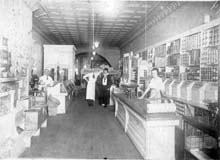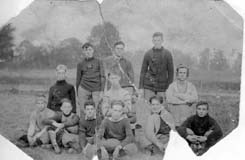October 4th, 2008
 Pearl Fisher lived at 129 West Pacemont for nearly 70 years until her death in 1970 at age 82. [The house has since been torn down.] She moved there as a young girl, when Pacemont (then called Jason Avenue), was a gravel road with houses far apart and the mailman traveled his route in a buggy. There was a spring on the West Pacemont farm which her parents, Mr. and Mrs. Joseph Fisher, owned. They sold this spring water in bottles to residents all over Clintonville, delivering it by horse-drawn wagon. They stored the bottles in a little shed attached to the house. –from The Booster, January 4, 1978.
Pearl Fisher lived at 129 West Pacemont for nearly 70 years until her death in 1970 at age 82. [The house has since been torn down.] She moved there as a young girl, when Pacemont (then called Jason Avenue), was a gravel road with houses far apart and the mailman traveled his route in a buggy. There was a spring on the West Pacemont farm which her parents, Mr. and Mrs. Joseph Fisher, owned. They sold this spring water in bottles to residents all over Clintonville, delivering it by horse-drawn wagon. They stored the bottles in a little shed attached to the house. –from The Booster, January 4, 1978.
Posted in 1900-1940, Businesses, Houses | 1 Comment »
October 3rd, 2008
 C. F. Jones Grocer used to be located at 2581 North High Street, where Schreiner’s Hardware Store is now. This image was taken around 1904 inside of the Jones Grocery Store. Shown are sons Charles and Clarence with their father Frank Jones.
C. F. Jones Grocer used to be located at 2581 North High Street, where Schreiner’s Hardware Store is now. This image was taken around 1904 inside of the Jones Grocery Store. Shown are sons Charles and Clarence with their father Frank Jones.
.
 This image of their delivery wagon dates from 1909. Charles Jones is besides the wagon and the young man holding the horse is unknown. They are standing in front of their store.
This image of their delivery wagon dates from 1909. Charles Jones is besides the wagon and the young man holding the horse is unknown. They are standing in front of their store.
.
 This photo of the C. F. Jones Grocer Co. was taken around 1916. Shown are Charles, Clarence, and their father Frank Jones.
This photo of the C. F. Jones Grocer Co. was taken around 1916. Shown are Charles, Clarence, and their father Frank Jones.
.
 This is a picture of the C. Frank Jones family in their home at 2665 Adams Avenue, Columbus, circa 1900. Bertha May Jones Aurand (1889-1934), Charles M. Jones (1895-1956), C. Frank Jones (1861-1937), Clarence A. Jones (1891-1950), Miriam Tozer Jones (1869-1941), Gladys A. Jones Reiger (1899-1930). (Photos courtesy of Frank Jones.)
This is a picture of the C. Frank Jones family in their home at 2665 Adams Avenue, Columbus, circa 1900. Bertha May Jones Aurand (1889-1934), Charles M. Jones (1895-1956), C. Frank Jones (1861-1937), Clarence A. Jones (1891-1950), Miriam Tozer Jones (1869-1941), Gladys A. Jones Reiger (1899-1930). (Photos courtesy of Frank Jones.)
Tags: North Columbus
Posted in 1900-1940, Businesses, People, Transportation | 1 Comment »
October 3rd, 2008
 Ed Herrick’s saloon, at 2568 North High Street in 1900. (Photo courtesy of Frank Jones.)
Ed Herrick’s saloon, at 2568 North High Street in 1900. (Photo courtesy of Frank Jones.)
Tags: North Columbus
Posted in 1900-1940, Businesses | No Comments »
October 3rd, 2008
 Kellar Barns & Livery Stable, rear of 2650 North High Street, in 1900. (Photocopy courtesy of Frank Jones.)
Kellar Barns & Livery Stable, rear of 2650 North High Street, in 1900. (Photocopy courtesy of Frank Jones.)
Tags: North Columbus
Posted in 1900-1940, Businesses, Transportation | 2 Comments »
October 3rd, 2008
 The second business north from the northwest corner of Hudson and North High Street, at 2579 North High Street, was Kroger’s. Look at the books lining the north side of the store! Frank Jones was the butcher and manager of the store. (Photo courtesy of Frank Jones.)
The second business north from the northwest corner of Hudson and North High Street, at 2579 North High Street, was Kroger’s. Look at the books lining the north side of the store! Frank Jones was the butcher and manager of the store. (Photo courtesy of Frank Jones.)
Tags: North Columbus
Posted in 1900-1940, Businesses | No Comments »
October 3rd, 2008

Here’s the 1908 Old North Columbus Boy’s Football Team. Top row: Lee Billing, Pick, Bud Campbell. Center Row: Daygo Matthews, Art Rodes, Harold Caine. Also in picture: Nate McCoy, Charles M. Jones, Gazaway Moccabee. (Photo courtesy of Frank Jones.)
Tags: North Columbus
Posted in 1900-1940, Parks & Recreation | 1 Comment »
October 3rd, 2008

Fallis Road in the Dominion Park Addition, in 1913, showing office, sidewalks and forms set ready for curb and gutter. –from Dominion Land Company Columbus Home News July 1913, Volume 1 Number 4.
Tags: Charles Johnson
Posted in 1900-1940, Houses | No Comments »
October 3rd, 2008
Sam Roshon, a former history department librarian at the Columbus Metropolitan Library, wrote this article about the original zoo for the present Columbus Zoo. The two zoos aren’t related except by sharing in the happy memories of Clintonville residents.
Tags: Beechwold
Posted in 1900-1940, Parks & Recreation | 5 Comments »
October 3rd, 2008

This wonderful arts and crafts-styled home on West Beechwold Boulevard was the gatekeeper’s house for the Columbus Zoo, originally located where Old Beechwold is today. It was renovated in the 1990s in the Arts and Crafts style and still has the original cistern.
Tags: Beechwold
Posted in 1900-1940, Houses | No Comments »
October 3rd, 2008

Joseph A. Jeffrey, a Columbus manufacturer, built this house around 1906 as a summer home. The land had previously been a zoo. Jeffrey’s wife called their estate Beechwalde, meaning “beech forest.” Jeffrey sold his property in 1914 to Charles H. Johnson, a Columbus land developer, who changed the name to Beechwold (because it was easier to spell) and sold plots for $1200. (Photo courtesy of the Columbus Metropolitan Libraries)
Tags: Beechwold, Charles Johnson
Posted in 1900-1940, Houses | No Comments »
 Pearl Fisher lived at 129 West Pacemont for nearly 70 years until her death in 1970 at age 82. [The house has since been torn down.] She moved there as a young girl, when Pacemont (then called Jason Avenue), was a gravel road with houses far apart and the mailman traveled his route in a buggy. There was a spring on the West Pacemont farm which her parents, Mr. and Mrs. Joseph Fisher, owned. They sold this spring water in bottles to residents all over Clintonville, delivering it by horse-drawn wagon. They stored the bottles in a little shed attached to the house. –from The Booster, January 4, 1978.
Pearl Fisher lived at 129 West Pacemont for nearly 70 years until her death in 1970 at age 82. [The house has since been torn down.] She moved there as a young girl, when Pacemont (then called Jason Avenue), was a gravel road with houses far apart and the mailman traveled his route in a buggy. There was a spring on the West Pacemont farm which her parents, Mr. and Mrs. Joseph Fisher, owned. They sold this spring water in bottles to residents all over Clintonville, delivering it by horse-drawn wagon. They stored the bottles in a little shed attached to the house. –from The Booster, January 4, 1978.










